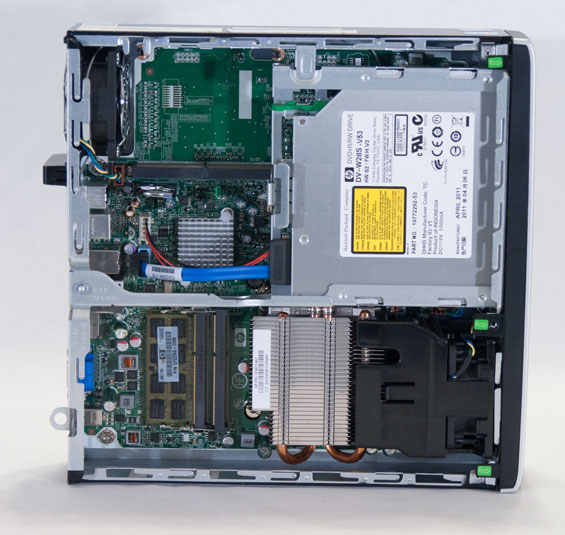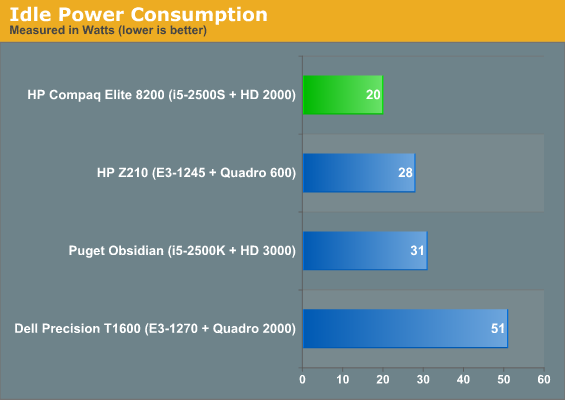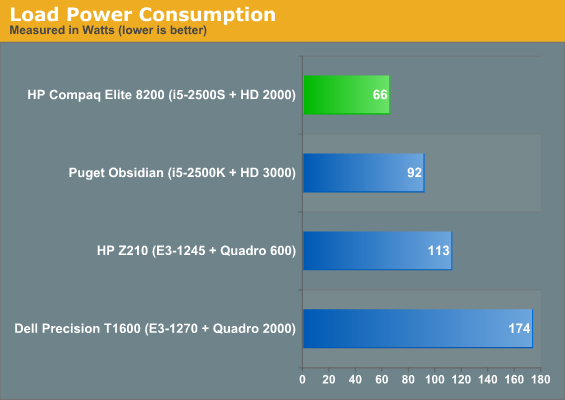HP Compaq 8200 Elite Ultra-Slim: The Littlest Desktop
by Dustin Sklavos on September 29, 2011 10:40 AM EST- Posted in
- Systems
- IT Computing
- HP
- SFF
- Enterprise
Build, Noise, Heat, and Power Consumption
Once again I have to state that I'm a big fan of how enterprise-class computers are built, specifically in regards to internal layout. Because these machines are designed to be easily serviced should the need arise, there are really quite a lot of intelligent ideas that go into how they're built that make me wonder why we don't see them more often on the consumer side. Take a look inside the wonderfully small HP Compaq 8200 Elite Ultra-Slim.

Everything is in its right place and extremely easy to service. Due to the smaller form factor, HP opts for mainly notebook parts inside the 8200 outside of the 65-watt processor. There's a substantial heatsink complete with copper heatpipes covering the processor, and a fan from the front channels air straight through it and out of the back of the case, cooling the memory in the process.
When I opened the 8200 the first time I was surprised to see the relatively large empty space in the top left corner; that MXM slot is actually there in case the system is custom ordered with a graphics upgrade, which can be cooled by the second small fan. The catch as noted earlier is that the only graphics upgrade available is an AMD Radeon HD 5450. Given the nature of this desktop, we can't say that upgrade is really worth it.

Considering the low power components of the 8200, it should come as no surprise that the system runs quietly and stays reasonably cool. The CPU temperatures aren't stellar (though they're still better than most notebooks we test), but this is also a very small enclosure, and HP has largely erred on the side of silence rather than performance. Since Sandy Bridge is already a cool-running architecture to begin with, this winds up being the right trade. Air circulation within the chassis also seems to be good enough to keep the 2.5" Western Digital Scorpio Black running cool.


Other than pure size, power consumption winds up being the 8200's trump card. With load power of just 66 watts, it's not hard to see why a business might want to deploy several of these for users who don't need extremely high-powered hardware. Idling at the desktop, it consumes a miserly 20 watts.














41 Comments
View All Comments
LoneWolf15 - Thursday, September 29, 2011 - link
In a mass-deployment market, "basically" that's a great solution.It takes up very little desk space, but can be set up so it won't walk away. Great option for K-12 education, or a secretary who needs all the room on his/her desk that can be had.
For the right price, I'd pick up a few dozen of these in Core i3 format for a basic computer lab, where they'd be perfect for the job.
Belard - Thursday, September 29, 2011 - link
I know.. and understand. Overall, I agree with the review of this HP computer.I would have gone for 2 USB in the front and at least 1 USB 3.0 in the back and of course, DVI should have been standard.... instead of VGA. VGA adapters are cheap.
JasperJanssen - Wednesday, October 12, 2011 - link
Business computers don't need USB 3. They barely need USB2 -- most businesses don't allow random USB devices beyond HID to be connected.praeses - Thursday, September 29, 2011 - link
These got nixed from my list because of the external power supply. Not only are they trickier from a cable management perspective but they also are more vulnerable to being disconnected and damaged.For some its not so much of an issue.
Adul - Thursday, September 29, 2011 - link
We just deployed a few hundred of these desktops for a customer of ours. The small form factor really helps out in the tight spaces many of these systems go in hallways. And the ton of USB ports is good to have with some setups having a lot of USB devices attached to them.MadAd - Friday, September 30, 2011 - link
agreed, ive been into car computing as well as running several light load home servers, this is a lovely little machine for so many tasks that a laptop cant quite handle but you wouldnt want to power a whole ATX box to do, plus bridges that ITX format space that no one has really managed to claim as their own just yet.What with graphics moving on die over the next few generations, all it needs is a push into this space now by companies like HP and I can see stacked power hungry ATX boxes becoming less attractive
Jaguar36 - Thursday, September 29, 2011 - link
A Mac mini just seems like a better all around option, less power, no external power brick, for this usage case its going to be just as fast. And far higher build quality.Nihility - Thursday, September 29, 2011 - link
You want to go from:4 cores @ 2.7 (turbo to 3.7) with 4 GB of RAM and a 3-year warranty
to
2 cores @ 2.3 with 2GB of RAM with a 1-year warranty?
And 4 less USB 2.0 ports (for what they'e worth)
Jaguar36 - Thursday, September 29, 2011 - link
You're comparing the base $600 Mac mini to the $917 review configuration.It doesn't matter though, as performance in this application is pretty much irrelevant, nobody using this PC is going to notice an extra 2 cores.
Nihility - Thursday, September 29, 2011 - link
Huge oversight on my part.Really only the warranty is a big difference in that case.